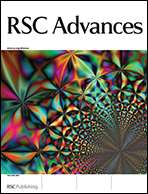Microwave-assisted synthesis of nitrogen and boron co-doped graphene and its application for enhanced electrochemical detection of hydrogen peroxide†
Abstract
A microwave-assisted strategy was developed for the synthesis of nitrogen and boron co-doped graphene (NB-G) with a hierarchical framework, and the NB-G was characterized by transmission electron microscopy, scanning electron microscopy, X-ray photoelectron spectroscopy and Raman spectroscopy. The resultant NB-G network provided multidimensional electron transport pathways, and was used in the electrocatalytic reduction for hydrogen peroxide (H2O2) sensing, exhibiting an excellent response and stability. The NB-G modified electrochemical sensor showed a linear range from 0.5 μM to 5 mM with a detection limit of 0.05 μM at a signal-to-noise ratio of 3. This high performance was attributed to both the beneficial structure of NB-G and synergetic effects arising from the co-doping of N and B in graphene. The proposed biosensor was also used to achieve real-time quantitative detection of H2O2 from living cells at the nanomolar level, which exhibited excellent electrochemical activity.


 Please wait while we load your content...
Please wait while we load your content...